Why Are Germany's Manufacturers Replacing Manual Handling with Pallet Inverters?
Your factory floor is a finely tuned engine. But what happens when one part of that engine relies on old, inefficient methods? Manual pallet handling is often that part. It’s slow, it’s a major safety risk for your team, and every damaged product is a direct hit to your bottom line. You see the costs of labor and worker compensation rising, while the pressure to increase output never stops. This constant struggle creates a bottleneck that slows down your entire operation, from receiving to shipping, undermining the efficiency you've worked so hard to build elsewhere. This is precisely why so many of Germany's world-class manufacturers are making a strategic shift. They are moving away from the past and investing in a solution that solves these problems at their core: the pallet inverter.
German manufacturers are replacing manual handling with pallet inverters to achieve three critical goals: boost operational efficiency, improve worker safety, and reduce costly product damage. This automation allows them to handle goods faster with fewer people, eliminate the physical strain and injury risks of manual lifting, and ensure products are transferred between pallets without loss. It is a direct, strategic response to rising labor costs and the intense global pressure to maintain a competitive edge through smarter, safer, and more reliable logistics.
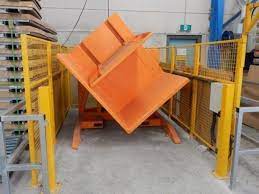
I understand that investing in new equipment is a big decision. As an engineer and factory owner myself, I've been in your shoes. You need to see a clear return on investment. The benefits of pallet inverters go far beyond a simple speed increase. They represent a fundamental change in how you handle materials, impacting everything from labor costs and safety compliance to supply chain reliability. Let’s break down the specific reasons why this technology has become essential for modern manufacturing in demanding markets like Germany. I'll share what I've learned over decades of designing and building these systems, and helping clients implement them for maximum impact.
How Do Pallet Inverters Directly Address Rising Labor Costs and Safety Concerns?
You look at your operational budget and see labor costs steadily climbing. At the same time, you know that a single serious back injury on the warehouse floor can lead to months of lost productivity and significant compensation claims. Manually lifting and restacking heavy goods from one pallet to another is the direct cause of both of these persistent problems. Imagine if you could remove that high-risk, labor-intensive task from your workflow entirely. This isn't just a fantasy; it's the immediate, practical benefit that a pallet inverter brings to your operation.
A pallet inverter directly attacks high labor costs by automating a task that would otherwise require two or three employees. This automation allows you to reassign those valuable team members to more complex, higher-value roles like quality control or machine operation. On the safety front, the machine does all the heavy lifting. By mechanically tilting and transferring the entire load, it eliminates the dangerous manual handling that is a primary cause of musculoskeletal injuries, helping you build a safer and more compliant workplace.
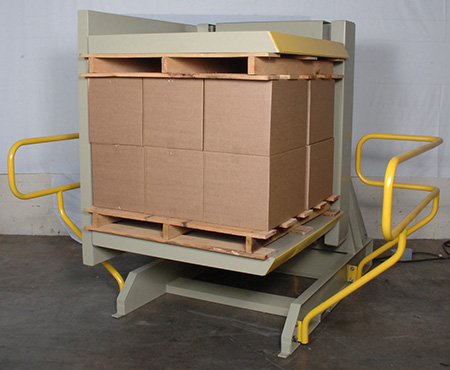
The True Cost of Manual Pallet Handling
When we talk about costs, wages are just the beginning. The real cost of manual handling is much higher when you look at the complete picture. As a factory owner, I've learned you have to account for both the direct and indirect expenses to understand the true impact on your profitability. Direct costs are obvious: the salaries, benefits, and potential overtime paid to the employees doing the lifting. But the indirect costs are often larger and more damaging.
These include:
- Worker Compensation: A single back injury can lead to claims costing tens of thousands of dollars, increasing your insurance premiums for years.
- Lost Productivity: When an employee is injured, they are not working. You also lose productivity from the team members who have to stop work to help, and from the supervisors who have to manage the incident and paperwork.
- Hiring and Training: High turnover in physically demanding jobs is common. The costs of recruiting, hiring, and training new employees to replace those who leave are substantial and recurring.
Let's compare the financial reality of manual handling versus using a pallet inverter.
| Cost Factor | Manual Handling (Team of 2) | Pallet Inverter (1 Operator) |
|---|---|---|
| Direct Labor | High (Wages for 2 employees) | Low (Wages for 1 part-time operator) |
| Injury Risk | Very High | Extremely Low |
| Insurance Premiums | Higher due to risk profile | Lower due to improved safety |
| Product Damage | Moderate to High | Negligible |
| Throughput Speed | Slow (10-15 pallets/hour) | Fast (30-40 pallets/hour) |
| Employee Turnover | High | Low |
This table shows that a pallet inverter is not just a piece of equipment; it's an investment that systematically reduces your biggest operational costs and risks.
Proactive Safety and Regulatory Compliance
In a market as regulated as Germany, or anywhere in the EU, workplace safety is not optional. Regulations like the German Occupational Safety and Health Act (Arbeitsschutzgesetz) place a strong emphasis on ergonomics and eliminating physical strain. A pallet inverter is a proactive tool for compliance. It doesn't just reduce risk; it engineers the risk out of the process. Manual lifting of heavy loads is classified as a high-risk activity. By automating it, you are demonstrating a clear commitment to providing a safe working environment. This can be a huge advantage during safety audits and inspections. More importantly, it builds trust with your employees. When they see you investing in technology that protects their health, morale and loyalty improve. They are no longer just laborers; they become skilled operators of advanced equipment. This shift is crucial for retaining good people in a competitive labor market.
What is the Real ROI of a Pallet Inverter in a High-Throughput Environment?
As a business owner, especially one with a background like Javier Morales who scrutinizes every investment, the question of Return on Investment (ROI) is paramount. You need to see a clear path for new equipment to pay for itself and start generating profit. With pallet inverters, many people make the mistake of only calculating labor savings. The true ROI, however, is a powerful combination of direct savings, recovered value, and massive efficiency gains that can transform your profitability, especially in a high-volume facility.
The real ROI of a pallet inverter in a high-throughput environment is calculated from a blend of tangible and intangible benefits. Tangible returns include drastically reduced labor costs, the near-total elimination of product damage during pallet transfers, and the ability to salvage goods from broken pallets. Intangibly, you gain significant throughput speed and operational flexibility. When all these factors are combined, the payback period for a pallet inverter is often surprisingly short, typically falling within 12 to 24 months.
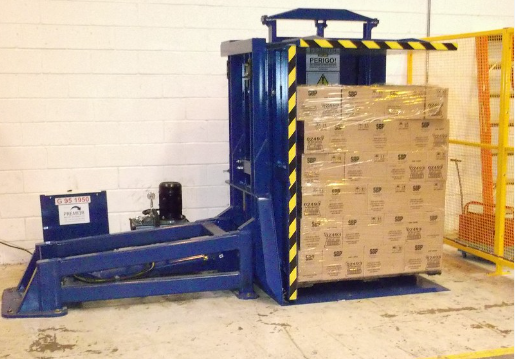
Calculating the Full Financial Return
To understand the complete financial picture, we need to break down the ROI calculation beyond a simple labor-for-machine swap. I always advise my clients to look at three main areas of tangible returns.
-
Labor Cost Reduction: This is the most straightforward calculation. Take the fully-loaded hourly wage of an employee (including benefits and taxes) and multiply it by the number of hours per day spent on manual pallet handling. Let's say two employees spend 4 hours a day on this task at a loaded cost of $25/hour each. That's 8 man-hours, or $200 per day. Over a 250-day work year, that's a direct saving of $50,000.
-
Product Damage Elimination: This is a hidden cost that many companies underestimate. Let's say your team transfers 100 pallets a day. If just 1% of those transfers result in damaged goods, and the average value of the damaged product is $200, you are losing $200 per day. That’s another $50,000 per year. A pallet inverter secures the load before transfer, making this loss virtually zero.
-
Increased Throughput Value: A manual team might transfer 10-15 pallets per hour. A pallet inverter can easily do 30-40. This speed means trucks are loaded and unloaded faster, production lines are fed without interruption, and you can process more goods in the same amount of time. Even a modest increase in overall output can translate to thousands of dollars in additional revenue each month.
A Hypothetical ROI Analysis
Let's put this into a table for a facility that handles high-value goods, similar to a steel plant or a chemical producer.
| Financial Metric | Annual Cost (Manual) | Annual Cost (Pallet Inverter) | Annual Savings |
|---|---|---|---|
| Labor (2 employees) | $100,000 | $0 (Reassigned) | $100,000 |
| Product Damage | $50,000 | ~$1,000 | $49,000 |
| Operator Cost (1) | $0 | $60,000 | -$60,000 |
| Maintenance | $0 | $2,000 | -$2,000 |
| Total Annual Savings | $87,000 |
If a robust pallet inverter costs, for example, $100,000, the payback period in this scenario is just over 13 months. For a business leader like Javier, who aims to reduce overall operating costs by 8%, an investment like this provides a clear, data-driven path to achieving that goal. The returns are not just theoretical; they are measurable improvements to the bottom line.
How Does Integrating a Pallet Inverter Improve Overall Supply Chain Efficiency?
Your factory might have the most advanced production machines, but if your logistics at the receiving and shipping docks are slow and manual, you have a critical weakness. This bottleneck can cause delays that disrupt your entire production schedule and damage relationships with both suppliers and customers. You've optimized the core, but the inefficiency at the edges is holding you back.
Integrating a pallet inverter improves overall supply chain efficiency by transforming a manual bottleneck into a smooth, automated hub. It acts as a bridge, allowing for the instant exchange of pallets to meet different requirements—such as swapping to hygienic plastic pallets for production, transferring to cheaper one-way pallets for export, or standardizing incoming loads. This speeds up the entire material handling process, making your supply chain more predictable, faster, and far more resilient.
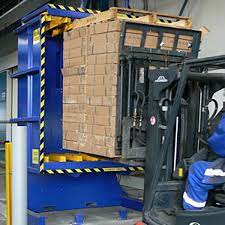
Creating a Seamless Flow from Start to Finish
I’ve seen this firsthand so many times. A company invests millions in production automation, but their supply chain still relies on men with forklifts and pry bars to deal with pallet issues. A pallet inverter creates a standardized, predictable process at the key transition points of your facility.
-
At the Receiving Dock: Your suppliers may send goods on low-quality or non-standard pallets. Instead of bringing these problematic pallets into your finely-tuned warehouse, you can use an inverter to quickly transfer the goods onto your high-quality, uniform internal pallets. This prevents damage to your own automated systems (like conveyors or ASRS) and improves warehouse safety and cleanliness from the very start.
-
Between Production and Warehouse: In many industries, especially food, beverage, and pharmaceuticals, goods must be moved from wooden pallets used in the general warehouse to hygienic plastic or aluminum pallets before entering a cleanroom production area. A pallet inverter automates this crucial step, ensuring compliance with GMP standards and preventing cross-contamination without manual handling.
-
At the Shipping Dock: This is where the machine often provides the most immediate value. You can keep your expensive, high-quality pallets in-house and transfer finished goods onto cheaper, one-way export pallets. This alone can save a company thousands of dollars a month in lost pallets. Furthermore, if your customer requires a specific pallet type (e.g., CHEP, Euro, US standard), you can make the switch in 60 seconds.
I remember a client in the chemical industry who was struggling with this. They produced bags of high-value powder. Their international customers required heat-treated ISPM 15 compliant pallets, but their internal pallets were not. Every export order involved a slow, messy process of manually unstacking and restacking 50-pound bags. It was a huge source of product damage, contamination risk, and worker injuries. We installed a pallet inverter right at their shipping bay. The problem vanished overnight. Their load times were cut by 75%, and their product damage claims dropped to zero. Their supply chain became reliable.
The Power of Pallet Standardization
For companies moving towards greater automation—like implementing MES systems or AGVs—standardization is everything. Automated Guided Vehicles (AGVs) and Automated Storage and Retrieval Systems (ASRS) work best with pallets of a known quality and dimension. A single broken board on a cheap pallet can cause a jam that shuts down an entire automated system. By using a pallet inverter at the receiving dock to transfer all incoming goods to your own high-quality, standardized pallets, you feed your automated systems the fuel they need to run smoothly. This simple step dramatically increases the uptime and reliability of your entire logistics infrastructure, helping you reach goals like the 95% equipment effective run time that forward-thinking leaders like Javier target.
Can Pallet Inverters Be Customized for Specific Industry Needs?
You might look at a pallet inverter and think it's a generic, one-size-fits-all box. But your products are unique. You might be handling heavy, unstable steel coils, fragile sacks of food ingredients, or sterile vials for the pharmaceutical industry. A standard machine designed for uniform boxes simply won't work for these specialized applications and could even cause more harm than good.
Yes, modern pallet inverters are highly versatile and can be extensively customized to meet precise industry requirements. As an engineer, this is where my work gets really interesting. We can modify everything from the clamping system and construction materials to the control logic. Whether you need stainless steel construction for hygienic wash-downs, wider platforms for oversized loads, or adjustable pressure for delicate products, the machine can be engineered to be a perfect fit for your specific operational needs.
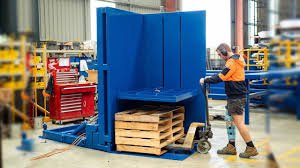
Engineering for Heavy Industries like Steel and Manufacturing
For a steel mill owner like Javier, standard equipment is rarely sufficient. The loads are heavier, the environment is harsher, and the products are often irregularly shaped. This is where robust engineering is critical. When a client from the steel industry comes to us, we don't start with a standard model. We start with their product.
- Load Capacity: Standard inverters might handle 1000-1500 kg. For steel coils, sheet metal, or engine blocks, we engineer systems with reinforced frames and upgraded hydraulics to safely handle loads of 2000 kg, 3000 kg, or even more.
- Clamping System: A simple top clamp won't work for a steel coil. We design specialized clamping mechanisms, sometimes with V-blocks or other custom cradles, to secure round or uneven objects safely during the 180-degree rotation.
- Platform Design: We can create larger or wider platforms to accommodate oversized pallets or products that overhang a standard pallet footprint.
- Durability: The machine is built with thicker steel plates and more robust components to withstand the demanding environment of a steel mill or heavy manufacturing plant.
Customization for Hygienic and Sensitive Environments
The needs of the pharmaceutical and food industries are the complete opposite of steel, but just as demanding. Here, the priority is not weight, but cleanliness and precision.
- Construction Material: For these applications, we build the entire machine, or at least all product-contact surfaces, from 304 or 316-grade stainless steel. This allows for aggressive wash-down procedures with cleaning agents to ensure hygienic standards are met.
- Adjustable Clamping Pressure: When handling fragile vials or soft bags, too much pressure can crush the product. We integrate pressure sensors and controls that allow the operator to set a precise, gentle clamping force, ensuring the load is secure but never damaged.
- Automation and Controls: For advanced facilities, we can integrate the pallet inverter directly into the production line with conveyors and safety systems. The machine's PLC can communicate with the plant's main MES, providing data and allowing for fully automated, "lights-out" operation.
The key is that the machine should adapt to your process, not the other way around. Below is a table showing how we approach customization for different needs.
| Feature | Standard Option | Custom Option | Industry Application |
|---|---|---|---|
| Construction | Painted Carbon Steel | 304 Stainless Steel, Galvanized | Food, Pharma, Chemical |
| Load Capacity | 1200 kg | 2000 kg, 3000+ kg | Steel, Automotive, Building Materials |
| Clamping Control | Fixed Hydraulic Pressure | Adjustable Sensor-Based Pressure | Fragile Goods, Electronics, Beverages |
| Automation | Push-Button Controls | Full PLC Integration with MES/SCADA | High-Throughput Warehousing, Automated Lines |
| Loading Style | Forklift Loading | Ground-Level Loading, Conveyor Feed | High-Traffic Areas, Ergonomic Focus |
My Insights
When I started as a young engineer on the factory floor, I saw problems like bottlenecks or damaged goods as technical failures. We would focus on fixing the immediate issue. But after starting my own factory and being responsible for the entire business, my perspective changed completely. I began to see these "problems" not as failures, but as signals. A bottleneck is your process telling you exactly where you can invest to get the biggest return. Product damage isn't just a loss; it's a map pointing to a weak link in your chain.
This is the mindset I see in the most successful German manufacturers, and it's the mindset I try to share with clients like Javier. They don't just buy a pallet inverter to replace manual labor. They use it as a tool to fundamentally re-engineer their material flow. They see it as a strategic investment to build a more resilient, efficient, and safer operation. The goal isn't just to reduce costs by 8%, but to build a system that is 50% more efficient and 100% safer.
The journey from being an employee to an owner has taught me that the best partnerships are built on shared understanding. When a client comes to me, my first questions are not about machine specs. They are about their process, their challenges, and their goals. What keeps them up at night? Is it rising energy costs? The pressure of environmental regulations? The difficulty in finding good people? A machine is just steel and wires. The solution is understanding how that machine can solve those deep, fundamental business challenges. My greatest satisfaction isn't just selling a piece of equipment; it's seeing a client use it to grow their business, to become more competitive, and to achieve their own financial independence. In helping them succeed, I found my own success. This is why I created SHJLPACK as a knowledge-sharing platform—because when we share our expertise, the entire industry rises together.
Conclusion
German manufacturers adopt pallet inverters not just for efficiency, but for a safer, smarter, and more resilient future. It is a strategic investment in long-term competitive advantage.




